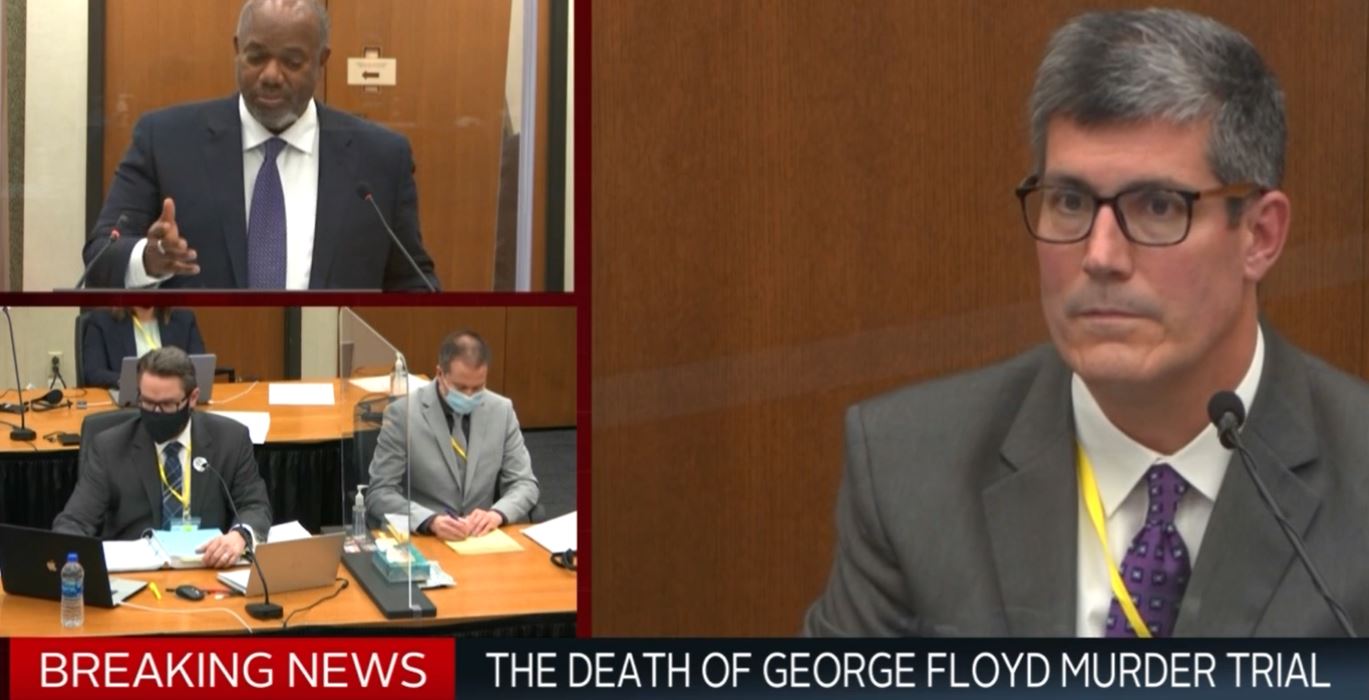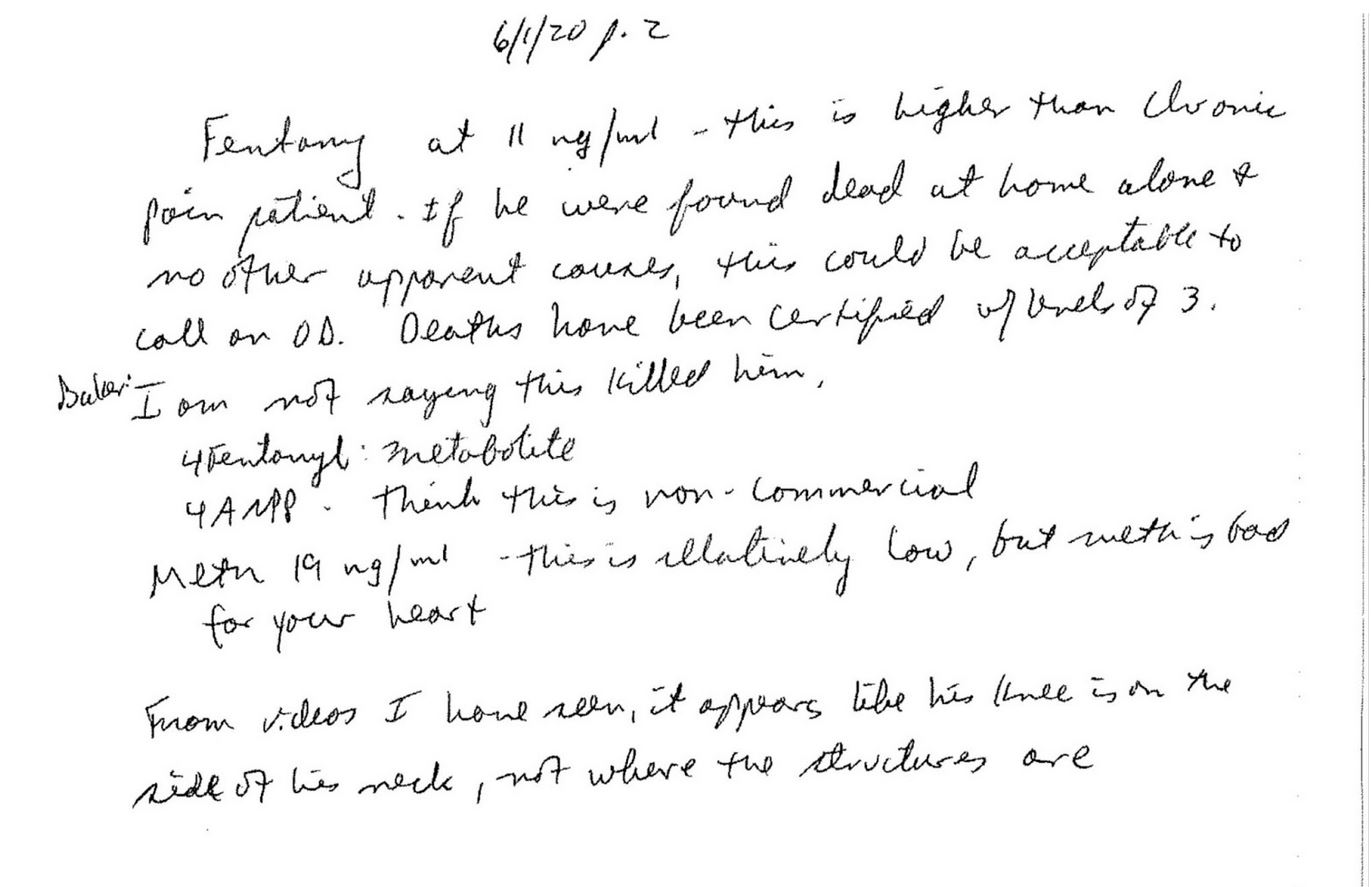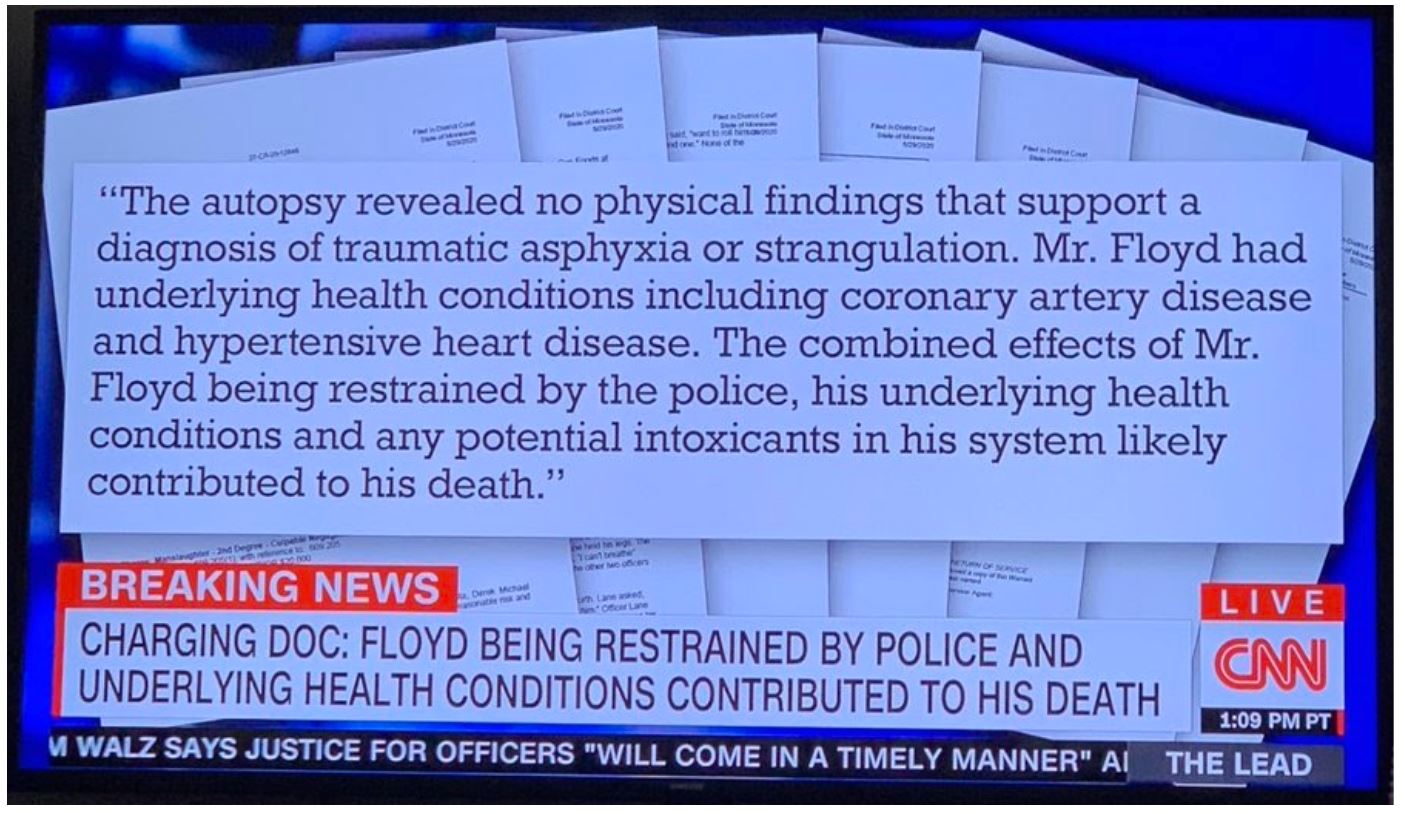Pathologists testifying on behalf of the state, including the medical examiner who performed the original autopsy of George Floyd, took center stage on Day 10 of the Derek Chauvin murder trial. Strangely, the findings of Dr. Andrew Baker, the actual person who examined Floyd, appear to be at odds with other expert witnesses representing the prosecution.
The cause of death is the crux of contention in the trial. The prosecution bears the burden of proving that the defendant is guilty beyond all reasonable doubt.
I would venture to say that breathing and what constitutes normal breathing is also a theme under scrutiny. Ironic under the Rona Regime.
Please follow Maryam Henein on Twitter
You can support her work on Patreon
Follow Maryam on Telegram and Gab
For — second-degree murder — to stick, the prosecution has to prove that Chauvin had the intent to attack Floyd by kneeling on his neck for more than eight minutes, unintentionally killing him in the process.
The prosecution is pointing to excessive force while the defense maintains Floyd died from a combination of the drugs in his system and various chronic health problems, including underlying heart disease.
Lindsey Thomas
Lindsey Thomas, a semi-retired forensic pathologist with more than 37 years of experience, started the day’s proceedings. Thomas who retired from the Hennepin County Medical Examiner’s Office in 2017 and still works part-time as a forensic pathologist in Reno and Salt Lake City, broke down the autopsy and affirmed that Chauvin’s actions led to Floyd’s death.
“What it means to me is that the activities of the law enforcement officers resulted in Mr. Floyd’s death,” Thomas said. “Mr. Floyd was in a position because of the subdual restraint and [neck] compression, where he was unable to get enough oxygen in to maintain his body functions.”
“In this case, I believe the primary mechanism of death is asphyxia or low oxygen.”
Thomas explained that although Floyd’s heart stopped, he didn’t die from a heart attack. She said the term “cardiopulmonary arrest,” isn’t unique — everyone’s heart and lungs stop when they die — but that forensic pathologists use the term to differentiate from cardiac arrest — a heart attack.
“The activities of the law enforcement officers resulted in Mr. Floyd’s death, and specifically those activities were the subdual restraint and the neck compression,” she said.
She noted that the sheer volume of videos of Floyd’s death was “absolutely unique” in that she’d never had a case so thoroughly documented, and it helped her arrive to determine how Floyd died.
“What I observed from all of these videos is this was not a sudden death,” Thomas testified. “It’s not like snow shoveling when someone clutches their chest and falls over. There was nothing sudden about his death.”
She later said, “there’s no evidence to suggest he would have died that night except for the interactions with law enforcement.”
Would he have died had he swallowed all those pills?
Thomas downplayed Floyd’s health challenges and drug use that were included by Baker and explained that such information is valuable for a “public health purpose” and not considered a direct cause of death.
“In any given case, we aren’t just thinking of this particular person,” Thomas said. “[Autopsy results] list disease processes or drugs that are present at the time of death, but we don’t believe they directly contributed to the cause of death.”
Thomas also downplayed the autopsy failing to mention lack of oxygen, or asphyxia, despite she and others who have testified to this being the direct cause of death.
“I tend not to use it,” she said, while also pointing out that there is no test during an autopsy to detect this cause. As an example, Thomas said, “I wouldn’t say asphyxia during hanging. I would just say hanging.”
She also added to previous medical expert witnesses concerning injuries on Floyd’s body that revealed his struggle to reposition himself to allow him to better breathe: such as scrapes on his knuckles, face, and shoulders.
The judge then had photos of the injuries distributed to the jurors, and Thomas explained what they depicted and why the images “are consistent that he is pushing himself so he can get in a position to breathe.”
Thomas testified that the bodily stress of being restrained in a prone position must be taken into account and has been absent in controlled research in this area.
“Mr. Floyd was already in a position where he was experiencing breathing and getting enough oxygen in this body,” she said. “On top of that, now there’s the physiological stress that’s putting increased demand on his heart, lungs, and muscles. … He’s using his strength to get himself into a position where he can breathe.”
Add in the release of adrenaline, rapid breathing, and other bodily reactions, she said, “it’s kind of a double whammy to his heart, lungs, his muscles, and his whole system.”
In cross-examination by defense attorney Eric Nelson, Thomas acknowledged that Floyd had a slightly enlarged heart that would require more blood and significantly narrowed arteries.
With those factors, along with the stress Floyd endured, “the heart has to work very, very hard in this case, right?” Nelson asked.
“Let’s take the police out of this,” he continued. “Let’s assume you found Mr. Floyd dead in his residence, no police involvement, no drugs, the only thing you found were these facts about his heart. What would you conclude is the cause of death?” Nelson asked.
“In those very narrow circumstances, I would probably conclude that the cause of death was his heart disease,” Thomas said.
Nelson revived his earlier questioning of witnesses pointing out to Thomas the lack of bruising on Floyd’s neck or elsewhere and how fentanyl and meth can be fatal, even in small amounts. Thomas agreed, but with qualified answers such as “it can” or there being numerous variables to consider.
Nelson said that when someone is in cardiac arrest and given a saline solution intravenously — as occurred in Floyd’s case — that procedure can decrease the number of controlled substances that would be measured in the body.
Thomas called that “a theoretical possibility.”
Blackwell rose again and took aim at Nelson’s scenario minus the police.
“Aren’t those questions a lot like asking, ‘Mrs. Lincoln, if we take John Wilkes Booth out of this …’ ” before Nelson objected and the judge sustained and explained the incomplete question was argumentative.”
After the court’s lunch break, Andrew Baker, the Hennepin County Medical Examiner who performed Floyd’s autopsy, took the stand.
STATE WITNESS #35 — Dr. Andrew Baker
Chief Medical Examiner Dr. Andrew Baker sideswiped some questions and agreed that the cause of George Floyd’s death was police subdual, restraint, and neck compression. He also reiterated that the manner of death was a “homicide.”
“I would still classify [Floyd’s death] as a homicide today,” Baker told the prosecution.
Medical examiners have five possible classifications when determining the cause of death: Natural, accident, suicide, homicide, and undetermined.
In Baker’s field of forensic pathology, homicide means “death at the hands of someone else.”
Baker ruled that Floyd’s cause of death on May 25 in Minneapolis was “cardiopulmonary arrest complicating law enforcement subdual, restraint, and neck compression.”
He clarified today that while he listed Floyd’s health issues as “significant conditions,” because he believed that they played a role in Floyd’s death, they were not direct reasons.
“In my opinion, the law enforcement subdual restraint and the neck compression was just more than Mr. Floyd could take, by virtue of those heart conditions,” medical examiner Andrew Baker said.
He did acknowledge Floyd had underlying heart disease — a slightly enlarged heart and multiple occluded coronary arteries — as well as fentanyl and methamphetamine in his system.
Note in his autopsy report he remarked, no life-threatening injuries were found.
What’s also interesting is that Baker stated in June that if Floyd were found dead at home alone and no other causes were apparent, “this could be acceptable to call an O.D…. I am not saying this killed him.”
He also noticed that it seemed Chauvin’s knee was placed on the side of his neck.
Baker was aware that Floyd became unconscious while he was in police custody and died at the hospital.
When he cited in his preliminary report that combined effects including drugs contributed to his death, he was scorned. Two commissioners actually tried to make sure Baker didn’t get his term renewed. They stated he caused “irreparable damage to the black community.” He was reappointed by the Hennepin County Board of commissioners in June for a fifth term, just a month after Mr. Floyd’s death.
Keep in mind that Thomas, who helped train Baker when he was a resident in the office, said what while she agreed with Baker’s determination, her declaration runs counter to Baker’s assessment as he could not say whether Floyd would have lived “but for” the officers’ use of force.
Baker has been with Hennepin since 2004, and he has said that his most memorable work experience was working on the autopsy of victims of the plane that crashed into the Pentagon on 9/11. The medical examiner’s office is responsible for examining all unexpected deaths in the counties of Hennepin, Scott, and Drake, according to its website.
Later in June 2020, a dozen physicians came out that “inaccurately portraying the medical findings from Floyd’s autopsy emboldens white supremacy under the cloak of authoritative scientific rhetoric.”
No kidding.
During Nelson’s cross-examination, Baker often either deferred to what he had previously said or to specialists such as pulmonologists like Dr. Martin Tobin from the day before, and toxicologists that had already testified during the trial.
Why the sideswipe? Given what I shared, is it fair to say that Baker may have some concerns for his livelihood?
In court, Baker also said he “intentionally chose” not to view the video of Mr. Floyd’s death until after he performed the autopsy, so as not to be biased in his findings.
While examining photos he took of Mr. Floyd during the autopsy, Baker said he observed injuries on Floyd’s face — bruising and scrapes on the left side of his forehead and left side of his cheek. There was also an abrasion on his left shoulder, he said, consistent with lying in the prone position on the sidewalk, and blunt force injuries on knuckles on the back of his right hand.
Dr. Baker told the jury he did not take a photograph of Mr. Floyd’s heart intact because he did not usually “photograph organs that appear to be perfectly normal,” he said.
Yet in another instance, he said the heart was enlarged. While Floyd had no visible or microscopic damage to his heart muscle, the arteries in Floyd’s heart were significantly narrowed due to scarring that he estimated in some locations at 75%. He also listed hardening and thickening of the artery walls and that his “heart weighed more than it should.” He also said that Floyd had “very severe underlying heart disease.”
Guess this is the new “perfectly normal?”
And yet because of these ‘perfectly normal’ “heart conditions,” the law enforcement subdual was “more than Mr. Floyd could take,” he added.
Baker also examined the contents of Floyd’s stomach during the autopsy, and said he did not find evidence of pills, but noted that he did not have the content tested in a lab. He also found a tumor in Mr. Floyd’s abdomen but said he had no reason to believe it contributed to his death.
Baker also testified that fentanyl or heart disease did not cause the subdual or neck restraint that led to George Floyd’s death.
Unlike his comrades, Baker did not include a lack of oxygen, or asphyxia, a cause that three medical expert witnesses firmly said was what killed Floyd as a result of Chauvin’s knee. Remember this is the actual man who inspected the body.
Dr. Martin Tobin magically knew from watching various videos that Floyd suffered brain injury about five minutes into his restraint on the street. But Baker said inspection of the brain and lungs also found nothing out of the ordinary.
The doctor and jury were also shown photos he took from the autopsy and also distributed to the jury, others in the courtroom but out of the view of the global Livestream audience.
Baker said one photo showed bruises and scrapes to his left eyebrow area. He said he suffered those injuries while “being pinned against the asphalt the night before.”
“In the prone position?” Prosecutor Jerry Blackwell said. “Yes,” Baker responded.
Baker then went on to go through other photos of other injuries to Floyd, again repeating the same conclusion about the source of the wounds.
An image of the parallel lines on Floyd’s wrists, he said, is “pretty typical of handcuff marks that we see at autopsy.”
In conclusion, Baker stood firmly behind his initial ruling. “My opinion remains unchanged,” Baker said as his testimony concluded. “That was my top line then, [and] it would remain my top line now.”
Chauvin had a guest in the courtroom for the first time, an unidentified Asian woman who sat in the family representative seat.
Prosecution testimony continues Monday.
You can read reports from past trial days at Maryam Henein’s article archive HERE.
Become a Patron!
Or support us at SubscribeStar
Donate cryptocurrency HERE
Subscribe to Activist Post for truth, peace, and freedom news. Follow us on Telegram, SoMee, HIVE, Flote, Minds, MeWe, Twitter, Gab and Ruqqus.
Provide, Protect and Profit from what’s coming! Get a free issue of Counter Markets today.





Be the first to comment on "Day 10 Derek Chauvin Murder Trial — Prosecution’s Own Witnesses Seem To Contradict Each Other"